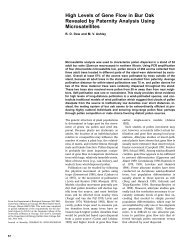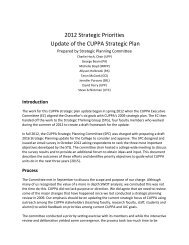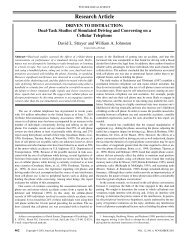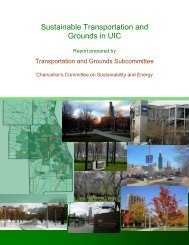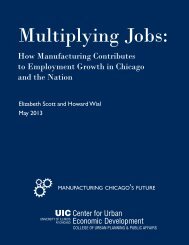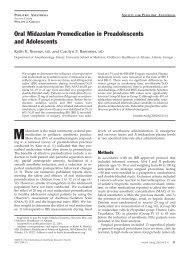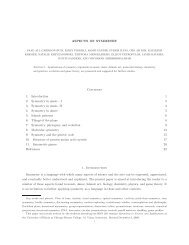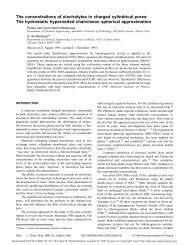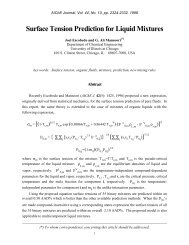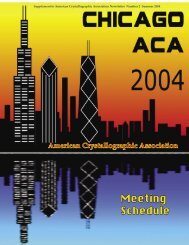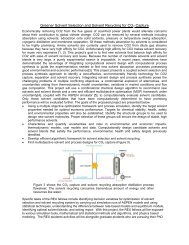Structure & Properties of Micelles and Micelle Coacervates of ...
Structure & Properties of Micelles and Micelle Coacervates of ...
Structure & Properties of Micelles and Micelle Coacervates of ...
You also want an ePaper? Increase the reach of your titles
YUMPU automatically turns print PDFs into web optimized ePapers that Google loves.
<strong>Structure</strong> & <strong>Properties</strong> <strong>of</strong> <strong><strong>Micelle</strong>s</strong> <strong>and</strong> <strong>Micelle</strong><br />
<strong>Coacervates</strong> <strong>of</strong> Asphaltene Macromolecule<br />
Slamet Priyanto (*) , G.Ali Mansoori (**) , <strong>and</strong> Aryadi Suwono (*)<br />
(*)<br />
Thermodynamics Research Laboratory<br />
IUC – B<strong>and</strong>ung Institute <strong>of</strong> Technology<br />
Jl. Tamansari 126, B<strong>and</strong>ung 40132 Indonesia<br />
(**)<br />
Department <strong>of</strong> Chemical Engineering<br />
The University <strong>of</strong> Illinois at Chicago<br />
810 S. Clinton Street, Chicago, IL 60607-7000, USA<br />
Key Words: <strong><strong>Micelle</strong>s</strong>, <strong>Micelle</strong> <strong>Coacervates</strong>, Asphaltene, Macromolecules<br />
Prepared for Presentation at 2001 AIChE Annual Meeting, Session # [90] – Nanotools<br />
And Publication in the Nanotechnology Proceedings<br />
AIChE Shall Not Be Responsible For<br />
Statements or Opinions Contained in Papers or Printed in its Publications<br />
1
ABSTRACT<br />
We have made some progress in studies towards formation <strong>and</strong> measurement <strong>of</strong> the<br />
behavior <strong>of</strong> asphaltene micelles nano-structures that might be formed to serve as elements <strong>of</strong><br />
nano-materials <strong>and</strong> also on synthetic strategies for creating such structures. An investigation <strong>of</strong><br />
the micellization <strong>and</strong> coacervation measurements <strong>of</strong> some well-characterized asphaltene<br />
molecules in polar solvents at various concentrations <strong>and</strong> temperatures are made. The critical<br />
micellization concentration (CMC) <strong>and</strong> the micelle coacervation point (MCP) <strong>of</strong> nano-structure<br />
asphaltene micelles are measured using viscometry. At concentration above the CMC,<br />
asphaltene in the solution will self-associate, saturation phase will be formed <strong>and</strong> then at a higher<br />
concentartion asphaltene nano-structure micelles in the solution will coacervate represented by a<br />
second sharp point <strong>of</strong> inflection corresponding to the asphaltene MCP <strong>and</strong> finally, at a higher<br />
concentration the aggregation <strong>of</strong> asphaltenes coacervates will occur.<br />
As a result <strong>of</strong> these measurements, for the first time it has become possible to produce<br />
phase diagrams for the whole range <strong>of</strong> asphaltene micellization <strong>and</strong> micelle coacervation.<br />
2
INTRODUCTION<br />
Asphaltene, resin, wax, etc. are heavy organic compounds which may exist in petroleum, heavy oil, tar s<strong>and</strong><br />
<strong>and</strong> coal in different quantities. Such compounds could precipitate out <strong>of</strong> petroleum fluids due to various forces<br />
causing fouling in the oil reservoir, in the well, in the pipeline <strong>and</strong> in the oil production <strong>and</strong> processing facilities.<br />
During refining <strong>of</strong> petroleum heavy organic compounds, including asphaltene, other heterocyclic compounds, heavy<br />
hydrocarbons <strong>and</strong> nonvolatile products will remain in the bottom <strong>of</strong> the refinery’s fractionation column as a very<br />
complex mixture known as “resid”. Our group is investigating unusual behavior <strong>of</strong> asphaltene molecules in<br />
petroleum fluids <strong>and</strong> in model systems that use pure solvents <strong>and</strong> well-characterized asphaltene molecules. Our<br />
interest in these molecules is to characterize their various phase transitions. These molecules are found to be the<br />
basic reason for fouling in the flow <strong>of</strong> petroleum fluids. The focus <strong>of</strong> the work on these unusual molecules is to<br />
characterize their structure, dynamics <strong>and</strong> thermodynamics, <strong>and</strong> to establish the relationship between these properties<br />
<strong>and</strong> petroleum fluid behavior. Asphaltene particles are believed to exist in petroleum partly dissolved <strong>and</strong> partly in<br />
steric-colloidal <strong>and</strong> / or micellar forms depending on the polarity <strong>of</strong> their oil medium <strong>and</strong> presence <strong>of</strong> other<br />
compounds in oil. In the last few years, the precipitation, flocculation <strong>and</strong> deposition <strong>of</strong> these molecules have been<br />
characterized <strong>and</strong> analyzed (Kawanaka et al 1989, Mansoori, 1997).<br />
A steric colloid is formed when a large non-soluble particle (asphaltene) is stabilized in the solution by<br />
adsorption <strong>of</strong> grafted polymers (resin) on its surface. The layer(s) <strong>of</strong> resin on large asphaltene particles will then<br />
repel each other if they are in a “good” solvent <strong>and</strong> this overcomes the van der Waals attraction so that the asphaltene<br />
particles will not aggregate. A micelle consist <strong>of</strong> a reversible assembly <strong>of</strong> molecules such as surfactants (asphaltene)<br />
that assemble together in a solution. Micellization is a phenomenon originally observed due to the self-association<br />
process <strong>of</strong> the surface active materials in aqueous solution. These surface active materials, known as surfactants, tend<br />
to self-assemble into geometric (disks, spheres, cylinders) shapes <strong>and</strong> become suspended in the solution. This<br />
phenomenon occurs only when the surfactant concentration exceeds a threshold known as critical micelle<br />
concentration (CMC). The change in properties that occur as micelles form is marked by sharp transitions in many<br />
physical quantities such as the surface tension, viscosity, conductivity, turbidity <strong>and</strong> nuclear magnetic resonance <strong>of</strong><br />
the solution (stupp et al 1997). Although micellization represents a self-association phenomenon in general, it is<br />
conventionally limited to the self-association initiated by the hydrophobic-hydrophilic imbalance. The hydrophobic<br />
part <strong>of</strong> the surfactant molecule tends to avoid contact with water, while the hydrophilic ionic head group tends to be<br />
strongly hydrated. Self-association <strong>of</strong> surfactant molecules into micelles can be seen as resulting from a compromise<br />
between the two different properties <strong>of</strong> the surfactant molecules (Jones <strong>and</strong> Gormally, 1983).<br />
If one starts with a solution <strong>of</strong> micelles in an appropriate solvent, then as a result <strong>of</strong> increase in micelle<br />
concentration a large part <strong>of</strong> the micelles can be separated out into a new phase. The original one phase system<br />
becomes two phases. One is rich <strong>and</strong> the other is poor in micelle concentration. The micelle-rich phase in a dispersed<br />
state appears as amorphous liquid droplets called coacervate droplets. Upon st<strong>and</strong>ing these coalesce into one clear<br />
homogenous micelle-rich liquid layer, known as the coacervate layer which can be deposited.<br />
MOLECULES MICELLES COACERVATE<br />
3
Whether the asphaltene particles are dissolved in petroleum, in steric-colloidal state or in micellar form,<br />
depends, to a large extent, on the presence <strong>of</strong> other particles (paraffins, aromatics, resins, etc.) in the petroleum. The<br />
existence <strong>of</strong> various nano-structures <strong>of</strong> asphaltenes in petroleum has been extensively discussed in numerous<br />
publications (Mansoori, 1997, Rogacheva et al 1980, Sachanen 1945, Sheu <strong>and</strong> Mullins 1995, Yen <strong>and</strong><br />
Chillingarian, 1994).<br />
A number <strong>of</strong> physical <strong>and</strong> chemical methods are available for construction <strong>of</strong> model structures for<br />
asphaltenes. Physical methods include IR, NMR, ESR, mass spectrometry, x-ray, ultra centrifugation, electron<br />
microscopy, small angle neutron scattering, small angle x-ray scattering, quasi elastic light scattering spectroscopy,<br />
VPO, GPC, etc. Chemical methods involve oxidation, hydrogenation, etc. Two <strong>of</strong> the representative structures for<br />
the asphaltene molecule belongs to the the Atabasca tar-s<strong>and</strong> bitumen <strong>and</strong> petroleum bitumens (Suzuki, et al 1982)<br />
<strong>and</strong> includes carbon, hydrogen, oxygen, nitrogen, sulphur as well as polar <strong>and</strong> non-polar groups as it is shown by<br />
Figure 1.<br />
Figure 1<br />
It has been recognized that petroleum asphaltene may form micellar particles in aromatic <strong>and</strong>/or polar<br />
solvents such as toluene <strong>and</strong> methyl-naphtalene (Galtsev1995, Mansoori, 1997, Rogacheva et al 1980, Sachanen<br />
1945, Sheu <strong>and</strong> Mullins 1995, Yen <strong>and</strong> Chilingarian, 1994). Small-size asphaltene particles may be dissolved in a<br />
petroleum fluid, whereas relatively large asphaltene particles may flocculate out <strong>of</strong> the solution, due to high paraffin<br />
content <strong>of</strong> the oil, forming r<strong>and</strong>om aggregates as shown in Figure 2.<br />
Figure 2<br />
Flocculation <strong>of</strong> asphaltene in paraffinic petroleum are known to be irreversible, having hysterises when the<br />
conditions are returned to pre-floculation point (Abedi et al 1998, Acevedo et al 1995, Birket 1997, Fuhr et al 1991).<br />
Due to their large size <strong>and</strong> their adsorption affinity to solid surfaces asphaltene flocs (r<strong>and</strong>om aggregates) can cause<br />
4
quite stable deposits which may not wash away by current remediation techniques. One <strong>of</strong> the effective <strong>and</strong> routine<br />
methods <strong>of</strong> remediation <strong>of</strong> heavy organic deposits is the use <strong>of</strong> strong aromatic solvents that could dissolve the<br />
asphaltene deposits (Acevedo et al 1995, Dubey <strong>and</strong> Waxman 1995, Kim et al 1990, Pacheco-Sanchez <strong>and</strong> Mansoori<br />
1997). Asphaltene flocs (aggregates) can form steric-colloids in the presence <strong>of</strong> excess amounts <strong>of</strong> resins <strong>and</strong><br />
paraffin hydrocarbons (Park & Mansoori, 1988, Mansoori 1997) as shown in Figure 3.<br />
Figure 3<br />
In this report the micellization <strong>and</strong> coacervation <strong>of</strong> asphaltene after it is separated from petroleum fluids <strong>and</strong> then<br />
dissloved in specific organic solvents are studied<br />
Asphaltene molecules may have an average molecular diameter around 5 Nm. Asphaltene micelles may<br />
have an average size around 25 Nm. Whereas micellar coacervates may have sizes greater than 25 Nm. Several<br />
experimental investigations have indicated that asphaltene micelles could be <strong>of</strong> spherical-like, cylindrical-like, or<br />
disk-like form (Espinat <strong>and</strong> Ravey 1993, Yen <strong>and</strong> Chilingarian, 1994). All these investigations are indicative <strong>of</strong> the<br />
fact that asphaltene particles may self-associate, but not flocculate, <strong>and</strong> form micelles in the presence aromatic<br />
hydrocarbons (or other polar solvents) as shown in Figure 4.<br />
Figure 4<br />
An example <strong>of</strong> asphaltene micelle coacervation is depicted in Figure 5.<br />
Figure 5<br />
The mechanisms <strong>of</strong> asphaltene flocculation <strong>and</strong> steric-colloid formation are well understood <strong>and</strong> modeled<br />
(Kawanaka et all 1989, Mansoori 1997). There exist also plenty <strong>of</strong> experimental data for asphaltene flocculation.<br />
Pacheco-Sanchez <strong>and</strong> Mansoori (1998) have developed a theoretical model to explain <strong>and</strong> quantify the phenomenon<br />
<strong>of</strong> asphaltene micellization <strong>and</strong> coacervation. This theory is also able to predict the nature <strong>of</strong> micelles from the<br />
phase diagram <strong>of</strong> the asphaltene micellization <strong>and</strong> coacervation. Despite the experimental evidence on the<br />
micellization <strong>of</strong> asphaltenes, to our knowledge no experimental data is available for the micelles coacervation point<br />
5
(MCP) <strong>of</strong> asphaltene. In what follows an accurate <strong>and</strong> reliable technique for measurement <strong>of</strong> micellization <strong>and</strong><br />
coacervation <strong>of</strong> asphaltene in pure solvents is reported <strong>and</strong> a number <strong>of</strong> representative measurements are made.<br />
EXPERIMANTAL PROCEDURE<br />
The experimental method proposed by Escobedo <strong>and</strong> Mansoori (1995 & 1997) to determine the onset <strong>of</strong><br />
asphaltene steric-colloid formation in petroleum through viscometry is proven to be equally applicable for the<br />
detection <strong>of</strong> asphaltene micelle formation in polar solvents. In the present study the phase diagram <strong>of</strong> asphaltene<br />
micellization <strong>and</strong> micelle coacervation in polar-organic solvents (1-methyl naphthalene) is investigated in the<br />
temperature range <strong>of</strong> 0-160 o C using the viscometry method.<br />
Two ranges <strong>of</strong> concentrations were used in this investigation; The low concentration range <strong>of</strong> 0.1-1.0 mg/g<br />
asphaltene in solvent. The high concentration range <strong>of</strong> 1-10 mg/g asphaltene in solvent. 1-methyl naphthalene was<br />
chosen as the solvent. The solutions were aged for 24 hours before measurement. This method is based on<br />
observations <strong>of</strong> the trend in the relative viscosity variations with increase in the concentration <strong>of</strong> asphaltene in a<br />
solvent. The points <strong>of</strong> inflection on plots <strong>of</strong> relative viscosity vs. concentration <strong>of</strong> asphaltene in 1-methyl naphthalene<br />
at various temperatures, corresponding to the critical micelle concentration (CMC) <strong>and</strong> micelle coacervation points<br />
(MCP), were determined. In this study we also have produced, both, lower <strong>and</strong> upper limits to micellization (CMC<br />
<strong>and</strong> micelle saturation points) as well as lower <strong>and</strong> upper limits to micelle coacervation (MCP <strong>and</strong> phase separation)<br />
which was never done before for asphaltene.<br />
The asphaltenes used in this study were two different kinds, Arabian medium heavy resid (AMHR)<br />
asphaltene obtained from Texaco Corp. <strong>and</strong> pentane-insoluble bitumen fraction (PIBF) asphaltene obtained from<br />
Syncrude in Canada. The 1-methyl naphthalene used in this study was produced by Aldrich Chemical Company,<br />
catalog no. M5,680-8 [90-12-0], 95% pure, BP. 240-243 o C, MP. -22 o C. The experiments were run at constant<br />
temperatures <strong>of</strong> 0-160 o C with increments <strong>of</strong> 10 o C for asphaltene in 1-methyl naphthalene (below boiling point <strong>of</strong> 1-<br />
methyl naphthalene). The solution viscosity was measured using glass capillary viscometer (Cannon-Fenske-Opaque)<br />
manufactured <strong>and</strong> calibrated by Industrial Research Glassware Ltd. for which calibration certificate was provided<br />
with the instrument. Two different viscometers, R14 <strong>and</strong> R15, were used to cover the viscosity ranges <strong>of</strong> all<br />
concentration <strong>of</strong> dilutions (low <strong>and</strong> high concentration). The viscometer constants were verified for accuracy using<br />
distilled water known viscosity data. Kinematics viscosities are based on the value for water adopted by the National<br />
Institute <strong>of</strong> St<strong>and</strong>ards <strong>and</strong> Technology <strong>and</strong> the American Society for Testing <strong>and</strong> Materials July 1, 1953. The<br />
kinematics viscosity basis is 1.0038 mm 2 /s (cSt) for water at 20 o C. The gravitational constant, g, is 980.1 cm/sec 2 at<br />
the Cannon Instrument Company. The gravitational constant varies up to 0.1% in the United States.<br />
Each kinematic viscosity point <strong>of</strong> asphaltene in 1-methyl naphthalene were measured three times to ensure<br />
the reproducibility <strong>of</strong> the data. Enough time was allowed for the dilution in each sample to reach thermal equilibrium<br />
(Escobedo <strong>and</strong> Mansoori, 1994 & 1997) before measurement was made. The equilibration time was determined<br />
experimentally based on samples in which asphaltene dilution had already occurred <strong>and</strong> no variation in the viscosity.<br />
During the determination <strong>of</strong> the equilibration time, the open end <strong>of</strong> the cuvette cell was capped to prevent solvent<br />
evaporation.<br />
6
RESULTS AND DISCUSSION<br />
The phase diagrams <strong>of</strong> Arabian Medium Heavy Resid asphaltene (AMHR) <strong>and</strong> pentane-insoluble bitumen<br />
fraction asphaltene (PIBF) micellization <strong>and</strong> coacervation in 1-methyl naphthalene solvent are produced in the<br />
temperature 0-160 o C <strong>and</strong> 0-180 o C, respectively, with increments <strong>of</strong> 10 o C. A series <strong>of</strong> experiments were performed<br />
to measure the effects <strong>of</strong> the changing concentration <strong>and</strong> temperature on asphaltene micellization <strong>and</strong> coacervation.<br />
Experimental observations reveal a decrease in the viscosity <strong>of</strong> asphaltene in 1-methyl naphthalene dilution as<br />
temperature increase <strong>and</strong> an increase in the viscosity <strong>of</strong> dilution as asphaltene concentration increase. Because <strong>of</strong> the<br />
self-association <strong>of</strong> asphaltene particles <strong>and</strong> asphaltene micelles sudden increases <strong>of</strong> viscosity <strong>of</strong> solution with<br />
increase <strong>of</strong> asphaltene concentration occur which can be accurately detected <strong>and</strong> measured. This experimental<br />
technique has an advantage over other techniques since the previous studies has the limitation <strong>of</strong> measuring only the<br />
micellization, <strong>and</strong> not coavervation, <strong>and</strong> for smaller temperature ranges.<br />
Relative viscosity<br />
1.02<br />
1.015<br />
1.01<br />
1.005<br />
1<br />
0.995<br />
0 5 10<br />
Concentration, mg/g<br />
Figure 6<br />
Figure 6 shows the results <strong>of</strong> relative viscosity measurements obtained for the PIBF asphaltene dissolved in<br />
1-methyl naphthalene in the concentration range <strong>of</strong> 0 - 10 mg/g at the constant temperature <strong>of</strong> 90 o C. As it can be seen<br />
from this figure variation <strong>of</strong> relative viscosity versus concentration for this mixture is not monotonic at all <strong>and</strong><br />
several sharp changes <strong>of</strong> slope are observed. In order to make a better recognition <strong>of</strong> these changes <strong>of</strong> slope the data<br />
<strong>of</strong> Figure 6 are divided into two zoomed out sections (0-1 mg/g <strong>and</strong> 1-10 mg/g <strong>of</strong> asphaltene in solvent) <strong>and</strong> Figures<br />
7 <strong>and</strong> 8 are reported.<br />
Relative viscosity<br />
1.01<br />
1.008<br />
1.006<br />
1.004<br />
1.002<br />
1<br />
0.998<br />
0 0.2 0.4 0.6 0.8 1<br />
Concentration, mg/g<br />
7<br />
Relative viscosity<br />
1.021<br />
1.019<br />
1.017<br />
1.015<br />
1.013<br />
1.011<br />
1.009<br />
1.007<br />
1 2 3 4 5 6 7 8 9 10<br />
Concentration, mg/g
Figure 7 Figure 8<br />
According to Figure 7, two distinct points <strong>of</strong> change <strong>of</strong> slope for the relative viscosity versus concentration<br />
<strong>of</strong> asphaltene in solvent are recognized in the 0-1 mg/g concentration range. The lower-concentration change <strong>of</strong><br />
slope point represents the critical micellization concentration (CMC) <strong>of</strong> asphaltene <strong>and</strong> the other (higher<br />
concentration) change <strong>of</strong> slope point represents the completion <strong>of</strong> micellization (or micellization saturation) point.<br />
According to Figure 8 also two distinct points <strong>of</strong> change <strong>of</strong> slope for the relative viscosity versus concentration <strong>of</strong><br />
asphaltene in solvent are recognized in the 1-10 mg/g concentration range. The lower-concentration change <strong>of</strong> slope<br />
point corresponds to the micelles coacervation point (MCP) <strong>of</strong> asphaltene <strong>and</strong> the other (higher concentration)<br />
change <strong>of</strong> slope represents the coacervate separation point. By repeating the relative viscosity measurement at<br />
various other temperatures in the range <strong>of</strong> 0-160 oC, <strong>and</strong> various concentrations <strong>of</strong> asphaltenes in polar solvents<br />
similar figures, as Figures 6-8, were obtained which provided us with the necessary data to construct the<br />
micellization, saturation, coacervation <strong>and</strong> phase separation diagrams <strong>of</strong> asphaltene in polar solvents as reported in<br />
Figures 9 <strong>and</strong> 10.<br />
Temperature, oC<br />
160<br />
140<br />
120<br />
100<br />
80<br />
60<br />
40<br />
20<br />
0<br />
0.01 0.1 1 10<br />
Concentration, mg/g<br />
CMC<br />
Sat.point<br />
Coac.point<br />
Separ.point<br />
Temperature, oC<br />
180<br />
160<br />
140<br />
120<br />
100<br />
80<br />
60<br />
40<br />
20<br />
0<br />
0.01 0.1 1 10<br />
CMC, mg/g<br />
CMC<br />
Sat.point<br />
Coac.point<br />
Separ.point<br />
Figure 9 Figure 10<br />
Figure 9 shows the measured data for phase diagram <strong>of</strong> PIBF asphaltene dissolved in 1-methyl naphthalene,<br />
which includes the CMC, saturation point, MCP <strong>and</strong> separation point for the temperature range <strong>of</strong> 0 - 160 o C with<br />
10 o C increment. According to this figure the CMC, saturation point, MCP <strong>and</strong> separation point get closer to one<br />
another as temperature increases. Figure 10 shows the measured data obtained for the phase diagram <strong>of</strong> AMHR<br />
asphaltene which has concentrations <strong>of</strong> 1.0 - 10.0 mg/g in 1-methyl naphthalene at the temperatures range <strong>of</strong> 0-<br />
180 o C. This data also includes the CMC, saturation point, MCP <strong>and</strong> separation point. According to this figure also<br />
the CMC, saturation point, MCP <strong>and</strong> separation point get closer to one another as temperature increases.<br />
The essence <strong>of</strong> nanotechnology is the ability to work at the molecular level, atom by atom, to create large<br />
structures with fundamentally new molecular organization. The aim is to exploit these properties by gaining control<br />
<strong>of</strong> structures <strong>and</strong> devices at atomic, molecular, <strong>and</strong> supramolecular levels <strong>and</strong> to learn to efficiently manufacture <strong>and</strong><br />
use these devices (NSTC 2000). Asphaltene micelles <strong>and</strong> coacervates are in this category <strong>of</strong> molecular-level<br />
structures which can have interesting <strong>and</strong> useful applications in nanotechnology. We have made some progress in<br />
8
studies towards formation <strong>and</strong> measurement <strong>of</strong> the behavior <strong>of</strong> asphaltene micelles nano-structures that might be<br />
formed to serve as elements <strong>of</strong> nanomaterials <strong>and</strong> also on synthetic strategies for creating such structures.<br />
Nanostructured asphaltene with structural features in the nanometer range can be also found in the form <strong>of</strong> micelle<br />
clusters known as coacervates. In addition, progress has been made in predicting the behavior <strong>of</strong> asphaltene micelle<br />
nano-structures at various temperatures <strong>and</strong> compositions in pure solvents. Our primary focus is to establish all the<br />
details <strong>of</strong> the nanostructure <strong>of</strong> asphaltene micelles <strong>and</strong> coacervates for future nanotechnology application. Nano<br />
sized materials can <strong>of</strong>ten be prepared by precipitant clusters <strong>of</strong> atoms in a liquid. The asphaltene micelle process may<br />
be used to produce nano-structured materials. The ultimate goal is to achieve a better underst<strong>and</strong>ing <strong>of</strong> the<br />
fundamental molecular processes <strong>and</strong> properties <strong>of</strong> these nano-structures which are dominated by grain boundaries<br />
<strong>and</strong> interfaces. In underst<strong>and</strong>ing the behavior <strong>and</strong> the properties <strong>of</strong> these nano-structures the potential for<br />
technological applications will be considered.<br />
ACKNOWLEDGEMENT: This research is supported by the Directorate General <strong>of</strong> Higher Education, Ministry <strong>of</strong><br />
Education <strong>and</strong> Culture, Republic <strong>of</strong> Indonesia, through URGE project, under grant No. 019/HTPP-II/URGE/1996.<br />
The authors would like to thank J. Escobedo <strong>and</strong> J.H. Pacheco-Sanchez for very helpful discussion.<br />
REFERENCES<br />
Abedi, S.J., Seyfaie, S. <strong>and</strong> Shaw, J.M.: “Unusual Retrograde Condensation <strong>and</strong> Asphaltene Precipitation in a Model<br />
Heavy Oil System” J. Petrol. Science & Technology, 16 (3&4), 209-226, 1998.<br />
Acevedo, S., Ranaudo, M.A., Escobar, G., Gutierrez, L. <strong>and</strong> Ortega, P.: “Adsorption <strong>of</strong> Asphaltenes <strong>and</strong> Resins on<br />
Organic <strong>and</strong> Inorganic Substrates <strong>and</strong> their Correlation with Precipitation Problems in Production Well<br />
Tubing”, Fuel, 74, 595-598, 1995.<br />
Birket, G.P., “Single-Phase Downhole Sampling for Asphaltenes”, in Proceedings <strong>of</strong> Controlling Hydrates, Paraffins<br />
<strong>and</strong> Asphaltenes Conf., IBC-UK Conf., Ltd, New Orleans, LA, Nov. 6-7,1997.<br />
Dubey, S.T. <strong>and</strong> Waxman, M.H.: “Asphaltene Adsorption <strong>and</strong> Desorption from Mineral Surfaces”, SPE Reservoir<br />
Engineering Journal, 389-395, 1995.<br />
Escobedo, J., <strong>and</strong> Mansoori, G.A., "Viscometric Determination <strong>of</strong> The Onset <strong>of</strong> Asphaltene Flocculation: A Novel<br />
Method," SPE Production <strong>and</strong> Facilities, May, pp. 115-118, 1995.<br />
Escobedo, J., <strong>and</strong> Mansoori, G.A., "Viscometric Principles <strong>of</strong> The Onsets <strong>of</strong> Colloidal Asphaltene Flocculation in<br />
Paraffinic Oils <strong>and</strong> Asphaltene Micellization in Aromatics”, SPE Production <strong>and</strong> Facilities, May, pp. 116-<br />
122, 1997.<br />
Espinat, D. <strong>and</strong> Ravey, J. C. “Colloidal structure <strong>of</strong> asphaltene solutions <strong>and</strong> heavy-oil fractions studied by smallangle<br />
neutron <strong>and</strong> x-ray scattering,” paper SPE 25187, presented at the 1993 SPE International Symposium<br />
on Oilfield Chemistry held in New Orleans, LA, March 2-5.<br />
Fuhr, B.J., Cathrea, L., Coates, Kalra, H., <strong>and</strong> Majeed, A.I. "<strong>Properties</strong> <strong>of</strong> Asphaltenes from a Waxy Crude," Fuel<br />
70, 1293, 1991.<br />
9
Galtsev, V. E., Ametov I. M. <strong>and</strong> Grinberg O. Y.: “Asphaltene association in crude oil as studied by ENDOR” Fuel<br />
74 , 670, 1995.<br />
Jones, E.W. <strong>and</strong> Gormally, J., 1983,”Aggregation Processes in Solution,” Elsevier Scientific Publishing Company,<br />
New York.<br />
Green, B.K.; Schleicher, L. U.S. Patent 2 800 457, 1957.<br />
Kawanaka, S., Leontaritis, K.J. Park, S.J. <strong>and</strong> Mansoori, G.A. "Thermodynamic <strong>and</strong> Colloidal Models <strong>of</strong> Asphaltene<br />
flocculationin "Oil Field Chemistry", ACS Symposium Series No. 396, Chapter 24, American Chemical<br />
Society, Washington, D.C. 1989.<br />
Kim, S.T., Boudh-Hir, M.E. <strong>and</strong> Mansoori, G.A.: "The Role <strong>of</strong> Asphaltene in Wettability Reversal", Proceedings <strong>of</strong><br />
the 1990Annual Convention <strong>of</strong> the Society <strong>of</strong> Petroleum Engineers, SPE Paper No. 20700, 1990.<br />
Mansoori , G.A. "Modeling <strong>of</strong> asphaltene <strong>and</strong> other heavy organics depositions", J. Petroleum Science &<br />
Engineering, vol. 17, pp.101-111, 1997.<br />
NSTC, "A Report by the Interagency Working Group on Nanoscience", Engineering <strong>and</strong> Technology Committee on<br />
Technology, National Science <strong>and</strong> Technology Council, Washington, D.C. February 2000.<br />
Pacheco-Sanchez, J.H. <strong>and</strong> Mansoori, G.A., 1997, “In Situ Remediation <strong>of</strong> Heavy Organic Deposits Using Aromatic<br />
Solvents,” Proceeding the Fifth Latin American <strong>and</strong> Caribbean Petroleum Engineering Conference <strong>and</strong><br />
Exhibition held in Rio de Janeiro, SPE Paper #38966, 30 Augst.-3 Sept. 1997.<br />
Pacheco-Sanchez, J. H. <strong>and</strong> Mansoori, G. A.: “Prediction <strong>of</strong> the Phase Behavior <strong>of</strong> Asphaltene <strong>Micelle</strong> / Aromatic<br />
Hydrocarbon Systems”, J. Petrol. Sci. & Technology, 16(3&4), 377-394, 1998.<br />
Park, S. J. <strong>and</strong> Mansoori, G. A.: “Aggregation <strong>and</strong> deposition <strong>of</strong> heavy organics in petroleum crude,” Energy<br />
Sources 10, 109, 1988.<br />
Rogacheva, O.V., Rimaev, R.N., Gubaidullin, V.Z., <strong>and</strong> Khakimov, D.K., "Investigation <strong>of</strong> The Surface Activity <strong>of</strong><br />
The Asphaltenes <strong>of</strong> Petroleum Residues," Ufa Petroleum Institute. Translated from Kolloidnyi Zhurnal,<br />
Vol. 42, No.3, PP.586-589, May-June 1980.<br />
Sachanen, A.N., ”The Chemical Constituents <strong>of</strong> Petroleum,” Reinhold Publishing Corp. 1945.<br />
Sheu, E.Y. <strong>and</strong> Mullins, O. C.(editors), "Asphaltenes Fundamentals <strong>and</strong> Applications", Plenum Press, New York<br />
1995.<br />
Stupp, S.I., V. LeBonheur, K. Wlaker, L.S. Li, K.E. Huggins, M. Keser,, <strong>and</strong> A. Armstutz. "Supramolecular<br />
materials: Self-organized nanostructures" Science, vol.276, pp.384-389, 1997.<br />
Suzuki, T., Ito, Y., Takegami, Y. <strong>and</strong> Watanabe, Y. "Chemical <strong>Structure</strong> <strong>of</strong> Tar-S<strong>and</strong> Bitumens by 13C <strong>and</strong> 1H<br />
NMR Spectroscopy Method" Fuel 61, pp. 402-410, 1982.<br />
Yen, T.F., <strong>and</strong> Chilingarian, G.V.(editor), "Asphaltenes <strong>and</strong> Asphalt, 1", Elsevier Science, Amsterdam, pp. 95-110,<br />
1994.<br />
10



